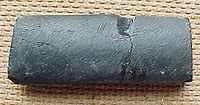Black Stone
Other names : Serpent Stone, Snake-stone, Viper’s Stone, Pierre Noire, Schlangenstein, Piedra Negra, Slangensteen, Belgian Stone.
The Black stone is black-gray in color and approximately 2cm x 5cm x 5mm. It is used as folk medicine for snake bite in Africa, South America and Asia. It's main characteristic is the strong sucking force that causes the poisoned blood from the wound is being pulled. The stone is also used for the treatment of other poisonous bites.
Contents
Special Precautions of Black Stone
- Experts are concerned that relying on a black stone may prevent snakebite victims from seeking appropriate medical help. No scientific study has shown that black stones per se are effective, but, most guidelines for Snakebite First-aid stress the need for keeping the victim calm (because acute stress reaction increases blood flow and endangers the victim, and panic is infectious and can compromise judgment).
- The stone doesn't replace treatment with the serum antidote, which is what is recommended, but in the absence of the serum it can be of great help. Seek further medical assistance.
Benefits and uses of Black Stone are
- Snakebites : thanks to its absorptive quality, works to neutralize the fatal effects of snakebite. It does not replace treatment with the serum antidote, which is what is recommended, but in the absence of the serum it can be of great help.
Views on snake-stones expressed in scientific studies
- A Nigerian study recommended "education on the need to avoid the use of popular first aid measures of doubtful benefit." The same doctors later reported that Black Stones may be beneficial, but "those who used the black stone required significantly higher quantity of antivenom as compared to those that used the tourniquet". In their report they noted slightly higher tissue necrosis in patients who use tourniquets, but this was not (statistically) significant; other scientists have recommended against tourniquets.
- A Bolivian medical study stated, "contrary to widespread belief, no efficacy to treat envenomation may be expected of the BS" (black stone)
- An Indian study stated, "unscientific methods like ‘black stone’ healing contribute to the delay in seeking appropriate medical care."
Operating Instructions
APPLY IMMEDIATELY AFTER A SNAKEBITE:
1) Wash the wound produced by the snake.
2) Make small cuts in the bite marks until drops of blood come out.
3) Place the Black Stone on the wound until it sticks there by itself.
4) Try to get the patient to stay calm and not move.
5) Treat the affected zone with antibiotics; those recommended are Penicillin G and Dicloaxacilina to treat infection. To ease the pain give the victim paracetamol.
Once the stone is used it can be re-used but first it must be soaked overnight in a glass of milk , and by morning the stone will be ready to be used again. The glass of milk must be thrown out because it is contaminated.
Composition of the Black Stone
HOW YOU CAN MAKE YOUR "BLACK STONE" :
1) Take a long bone from the hindquarters of a buffalo, a cow or an ox; preferably an old bone because it has very little fat.
2) Wash it, rub it well with detergent, dry it, wash it again at least three times so that it has no grease or oil on it.
3) Cut it in pieces approximately 5 centimeters by 2 centimeters.
4) File it down in order to open the pores of the bone.
5) Put wood coal on a metal sheet, heat it until the metal is very hot.
6) When the metal sheet is very hot, open the coal and put the pieces of bone in a row on it and re-cover with coal, allowing for good air circulation so that the coal burns well.
7) Keep the bones covered with coals for 15 minutes.
8) Uncover after 15 minutes to see whether the bones are black and shiny. If they are only brown, cover again and leave in the fire.
9) If the bones are very black and shiny, take them out with tongs and put them in untreated cold water from a well, a spring or a river (do not put them in water treated with chlorine or in boiled water) for several seconds. This makes the stone harder.
TO TEST ITS ABSORPTIVE POWER
Put the Black Stone on the tongue of a volunteer and if it sticks like glue, it is ready to be used. Remove it by dampening around the stone with water
References
- http://reap-eastafrica.org/blogs.info/reap/pdf/blackstone.pdf
- http://www.wmhelp.be/uncategorised/112-slangensteentje-nl.html
- JKA Madaki, RE Obilom, BM Mandong (2005). "Pattern of First-Aid Measures Used by Snake-bite Patients and Clinical Outcome at Zamko Comprehensive Health Centre, Langtang, Plateau State". Nigerian Medical Practitioner 48 (1). Retrieved 2010-10-15.
- BBC News (2005-05-02). "Search for a snakebite cure". Retrieved 2007-03-06.
- Tagne, Jean-Bruno. "Pierre noire : Cet aspirateur de venins / Black Stone: This vacuum cleaner of venoms" (in French). Retrieved 2007-03-06.
- Adhisivam, S. Mahadevan (2006). "Snakebite Envenomation in India: A Rural Medical Emergency". Indian Pediatrics 43: 553–4. Retrieved 2010-10-15.
- Dr. Linnea Smith. "Piedra Negra". Retrieved 2007-03-07.
- CongoForum. "La pierre noire et son usage / The Black Stone and its use" (in French). Retrieved 2007-03-06.
- Shuker, Karl P N (2007). Extraordinary Animals Revisited. CFZ Press.
- Rural Extension with Africa's Poor. "Black Stone". Retrieved 2007-03-07.
- JKA Madaki. "Abstract: Clinical Presentation And Outcome Of Snake-Bite Patients At Zamko Comprehensive Health Centre, Langtang, Plateau State". Retrieved 2007-03-08.
- Chippaux JP, Ramos-Cerrillo B, Stock RP (April 2007). "Study of the efficacy of the black stone on envenomation by snake bite in the murine model". Toxicon 49 (5): 717–20. doi:10.1016/j.toxicon.2006.11.002 . PMID 17174999.
